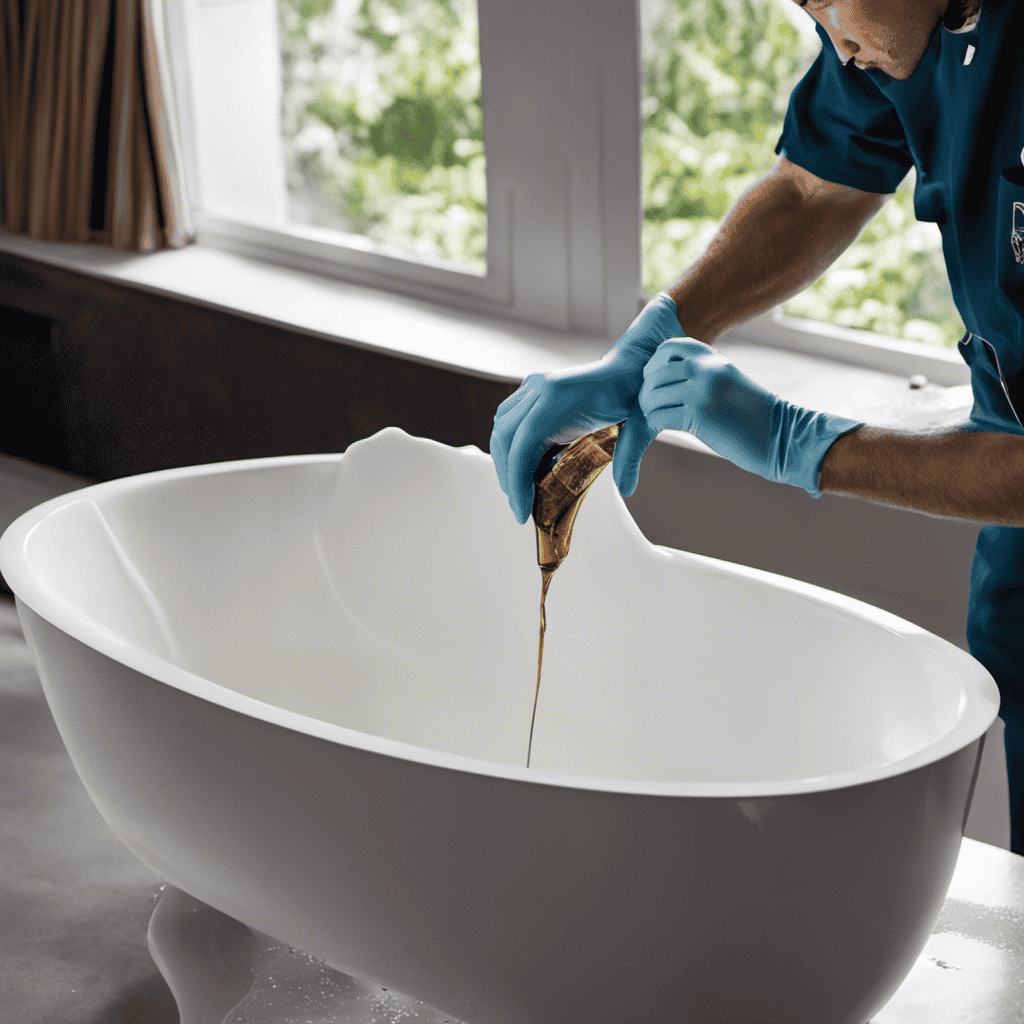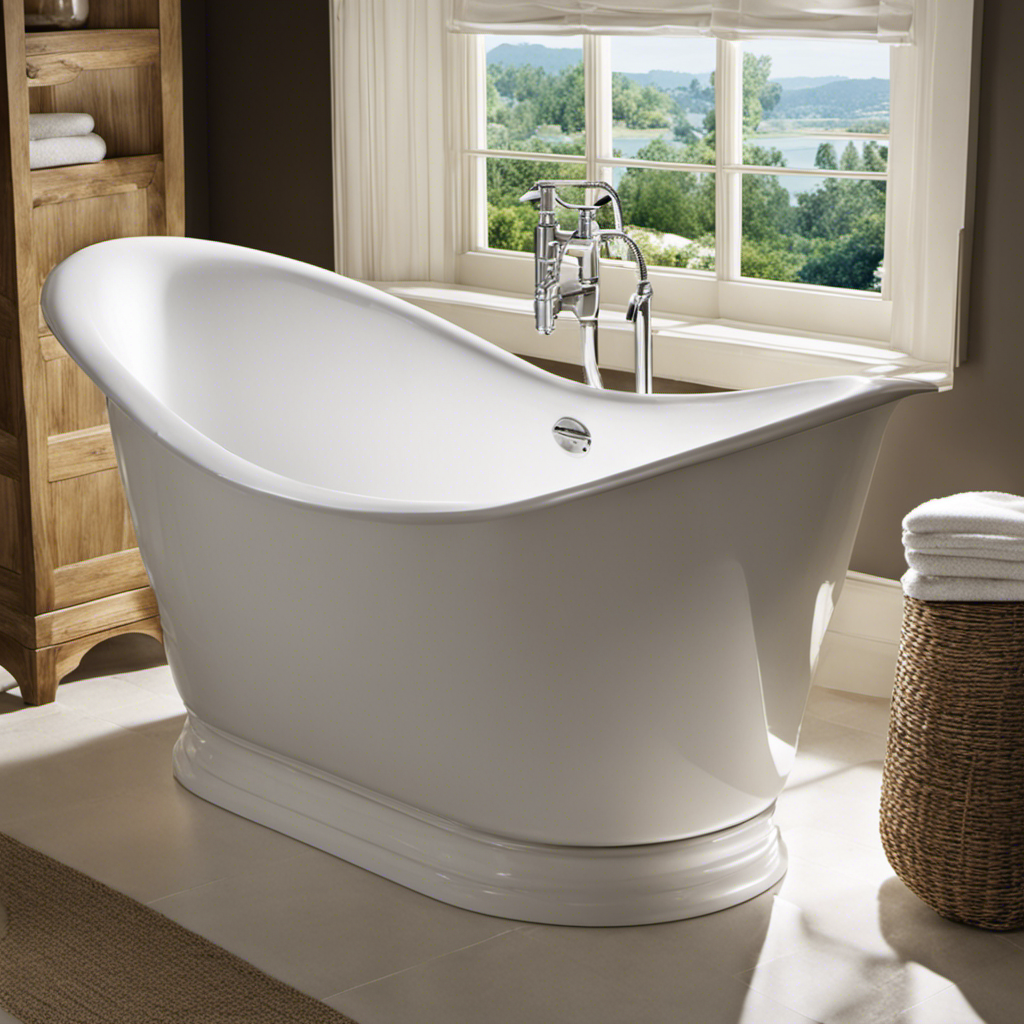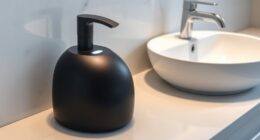As the saying goes, ‘Out of sight, out of mind.’ But have you ever wondered where the water from your bathtub overflow actually goes?
In this article, I will delve into the intricate workings of the drainage system and shed light on the journey of that excess water.
From the plumbing connections to the sewer line connection and even the municipal sewer system or septic tank and drainfield, we will explore the various pathways and potential issues along the way.
So, let’s dive in and uncover the mystery behind bathtub overflow water disposal.
Key Takeaways
- Bathtub overflow water goes into the municipal sewer system.
- It is treated at the treatment plant before being released into the environment.
- The municipal sewer system manages and treats bathtub overflow water.
- This process protects public health and the environment and ensures compliance with quality standards.
The Drainage System
When the bathtub overflows, the excess water goes down the drainage system. The drainage system is a crucial component of any plumbing system as it ensures the proper flow of water and prevents any potential water damage.
To understand how the water flow is managed, it’s important to consider the maintenance of the drainage system. Regular drainage maintenance is essential to prevent clogs and blockages that can impede the flow of water. This includes cleaning out any debris or buildup that may accumulate over time.
Additionally, it is advisable to use drain covers or strainers to catch any hair or larger particles that could potentially cause blockages. By maintaining the drainage system, you can ensure smooth water flow and prevent any overflow situations in your bathtub.
Plumbing Connections
When it comes to plumbing connections, understanding the drainage system connections and the function of the overflow pipe is crucial.
Drainage system connections refer to the network of pipes that connect various fixtures, such as sinks, toilets, and showers, to the main sewer line. These connections ensure the proper flow of wastewater and prevent any potential leaks or blockages.
On the other hand, the overflow pipe serves as a safety feature, preventing water from overflowing and causing damage in case of a blockage or excessive water flow.
Drainage System Connections
If your bathtub overflows, the water goes down the drain and connects to the drainage system. To prevent bathtub overflow, consider these measures:
- Install an overflow drain cover: This prevents water from rising too high and overflowing the tub.
- Regularly clean the drain: Hair and debris can accumulate over time, causing clogs and potential overflow issues.
- Check the drain trap: Ensure that the drain trap is clear of any obstructions that could impede proper drainage.
- Maintain proper water levels: Avoid filling the tub to the brim, as this increases the risk of overflow.
Proper drainage maintenance is crucial for preventing bathtub overflow. By following these steps, you can minimize the chances of water overflowing and causing damage.
Now, let’s explore the function of the overflow pipe in more detail.
Overflow Pipe Function
To prevent potential damage, it is important to understand the function of the overflow pipe. The overflow pipe is an essential component of a bathtub’s drainage system. Its primary function is to prevent water from overflowing onto the floor. It redirects excess water from the bathtub to the drain, ensuring that the water level remains below the rim of the tub. This prevents flooding and potential water damage to the surrounding area.
Proper maintenance of the overflow pipe is crucial to ensure its effectiveness. Regularly check for any clogs or blockages that may hinder the flow of water. You can use a plumbing snake or a mixture of baking soda and vinegar to clear any debris. Additionally, inspect the overflow plate and gasket for any signs of wear or damage. If necessary, replace them to prevent leaks.
Understanding the function and maintenance of the overflow pipe is an important step in bathtub overflow troubleshooting. Now let’s move on to the next section, where we will explore the sewer line connection.
Sewer Line Connection
When it comes to plumbing system connections, it’s crucial to ensure that all components are properly connected and functioning.
This includes the sewer line connection, which plays a vital role in drainage and waste management.
Additionally, implementing overflow prevention measures is essential to prevent any potential damage or flooding in the plumbing system.
Plumbing System Connection
The bathtub overflow water goes through the plumbing system connection. Here’s how it works:
-
Water flow: When the water level in the bathtub reaches a certain height, the overflow drain kicks in to prevent the water from overflowing onto the bathroom floor.
-
Drainage system: The overflow drain is connected to the plumbing system, specifically the waste pipe, which carries the wastewater away from your home.
-
Trap: Before the water enters the plumbing system, it passes through a trap, which is a curved section of pipe that holds water to prevent sewer gases from entering your home.
-
Sewer line: Once the water flows through the trap, it enters the main sewer line, which is connected to the municipal sewer system or a septic tank, depending on your location.
Understanding the path of the bathtub overflow water through the plumbing system connection ensures proper drainage and prevents water damage in your home.
Drainage and Waste Management
Proper drainage and waste management are crucial for preventing water damage in your home. When it comes to the bathtub, ensuring that water is efficiently drained and waste is properly disposed of is essential.
The water that goes down the drain is directed to the sewage system, where it undergoes water treatment processes to remove impurities and contaminants. This is important not only for maintaining the cleanliness of your home, but also for minimizing the environmental impact of wastewater. By treating the water, harmful substances can be removed before it is released back into the environment.
However, despite these measures, it is still important to have overflow prevention measures in place to avoid any potential water damage.
Overflow Prevention Measures
Ensuring the efficient draining and proper disposal of waste in the bathtub is essential to prevent water damage. To prevent overflow and water damage, here are four techniques you can implement:
-
Install an overflow drain cover: This cover prevents water from overflowing by diverting it back into the drain.
-
Use a drain strainer: This simple tool catches hair and debris, preventing them from clogging the drain and causing water to overflow.
-
Regularly clean the drain: Buildup of soap scum and other substances can restrict water flow, increasing the risk of overflow. Regularly cleaning the drain helps maintain proper drainage.
-
Adjust the water level: Some bathtubs have adjustable water levels. By setting it at a lower level, you can decrease the risk of overflow.
Implementing these overflow prevention techniques will help safeguard your bathroom against water damage and keep your bathtub in optimal condition.
Municipal Sewer System
When your bathtub overflows, the excess water goes into the municipal sewer system. This system is designed to handle the wastewater from various sources in a community, including residential, commercial, and industrial areas.
The water from your bathtub, along with wastewater from toilets, sinks, and other drains, is transported through a network of underground pipes to a municipal treatment plant. At the treatment plant, the water undergoes a series of processes to remove impurities and contaminants before it is released back into the environment. These processes include physical, chemical, and biological treatments to ensure that the water meets the required quality standards.
Additionally, the municipal sewer system plays a crucial role in stormwater management by collecting rainwater and preventing flooding in urban areas. With its comprehensive infrastructure and treatment processes, the municipal sewer system effectively manages and treats the bathtub overflow water, ensuring the protection of public health and the environment.
Moving on to the next topic, septic tank and drainfield…
Septic Tank and Drainfield
You might be familiar with septic tank and drainfield systems if you live in a rural area without access to a municipal sewer system. These systems are designed to treat and dispose of wastewater from your home.
Here are four important things to know about septic tank maintenance and drainfield installation:
-
Regular Pumping: Septic tanks should be pumped every 3-5 years to remove solid waste buildup and prevent clogs. This maintenance task is crucial for the longevity and efficiency of the system.
-
Proper Water Usage: Conserving water and using it efficiently can help prevent overloading the septic system. Be mindful of excessive water usage, such as running multiple appliances simultaneously or taking long showers.
-
Avoid Harsh Chemicals: Harsh chemicals, such as bleach, drain cleaners, and antibacterial soaps, can disrupt the natural bacteria in the septic tank and hinder its proper functioning. Use septic-safe products instead.
-
Professional Installation: Drainfield installation requires careful planning and expertise. It is essential to hire a professional to ensure proper sizing, placement, and construction of the drainfield for optimal wastewater treatment and disposal.
Regular septic tank maintenance and proper drainfield installation are essential for a well-functioning and long-lasting septic system. Follow these guidelines to ensure the efficiency and longevity of your system while minimizing potential issues and costly repairs.
Backflow Prevention Mechanisms
To prevent contamination of your drinking water, it’s important to have backflow prevention mechanisms in place. Backflow prevention techniques are essential to ensure that water flows in the right direction, preventing any unwanted substances from entering the drinking water supply.
One area where backflow prevention is crucial is in bathtub overflow mechanisms. When a bathtub overflows, it can lead to water flowing back into the plumbing system, potentially contaminating the water supply. To prevent this, backflow prevention devices, such as check valves or air gaps, are installed in the plumbing system. These mechanisms ensure that water flows in only one direction, preventing any backflow and protecting the drinking water from contamination.
It is important to regularly maintain and test these backflow prevention mechanisms to ensure their effectiveness in safeguarding your drinking water.
Potential Issues and Maintenance Tips
Regular maintenance and inspection of backflow prevention mechanisms is crucial to ensure the continued protection of your drinking water supply.
When it comes to bathtub maintenance, there are several common issues that can arise. Here are four tips to help you keep your bathtub in top shape:
-
Check the overflow drain regularly to ensure it is free from debris and functioning properly. Clogs in the overflow drain can cause water to back up and potentially overflow, leading to water damage.
-
Inspect the bathtub drain stopper for any signs of damage or wear. A faulty drain stopper can result in water leakage and make it difficult to keep the bathtub filled.
-
Clean the bathtub regularly to prevent the buildup of soap scum, mildew, and grime. This will not only keep your bathtub looking clean but also prevent any potential issues caused by clogged drains.
-
Address any leaks or drips promptly. Even small leaks can lead to bigger problems over time, such as water damage and mold growth.
Conclusion
In conclusion, understanding where bathtub overflow water goes is crucial for proper home maintenance. Whether you have a sewer line connection or a septic tank and drainfield, it is essential to have a functional drainage system in place.
Backflow prevention mechanisms play a vital role in preventing any potential issues. Regular maintenance, such as cleaning the drains and checking for any blockages, is necessary to ensure the smooth flow of water.
By taking these steps, you can avoid any water damage and keep your plumbing system running efficiently.










